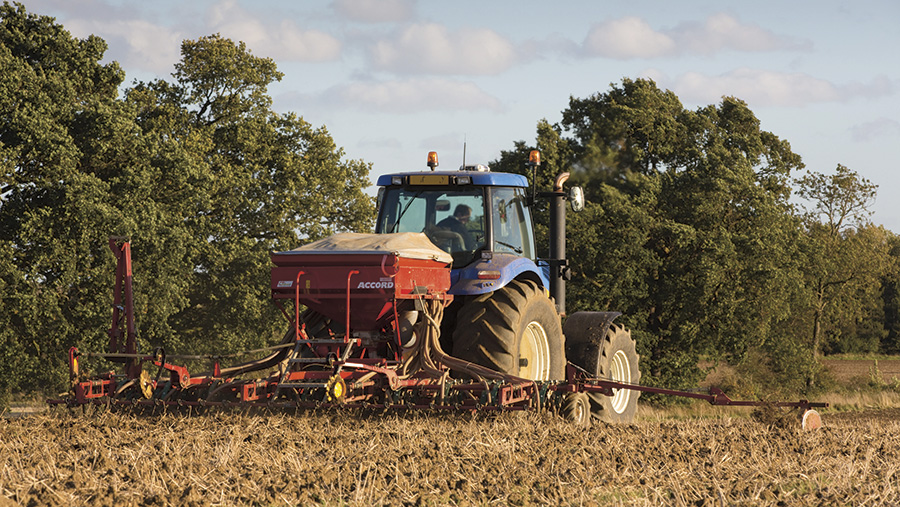Crop Watch: Growers who delayed drilling will see benefits
 © Tim Scrivener
© Tim Scrivener The temptation to drill early this autumn has been too much for some cereal growers in such dry generally favourable conditions and Ryan Hudson believes blackgrass will be a massive problem in some crops.
For those who held back, their patience will pay off with better control.
David Martindale agrees and adds some autumn rain would have been good to force growers to hold off cereal drilling and also give better conditions to create good seed-beds.
Todd Hunnisett reports problems with oilseed rape establishment in such dry conditions, while Neil Potts says cereal growers need to guard against the aphid-spread barley yellow dwarf virus in such a mild and dry autumn.
See also; Aphid threat to oilseed rape crops needs monitoring, farmers told
East: Ryan Hudson
Farmacy (Hertfordshire/Bedfordshire)
 Drilling has been relatively stress free over the past month with near perfect seed-beds.
Drilling has been relatively stress free over the past month with near perfect seed-beds.
The concern is that without moisture, blackgrass has not germinated pre-drilling and herbicide pre-emergence performance will be compromised in the dry conditions.
This is now evident in the early drilled fields as the crop and blackgrass are emerging in tandem and with perfect seed-beds and little surface moisture.
Blackgrass is likely to be a massive issue in some early drilled fields.
With dry conditions, we have eased back on pre-emergence residuals and additional flufenacet and partner products will be applied when we get sufficient moisture with more blackgrass still to germinate.
Where drilling has been delayed on the worst fields, blackgrass has been slowly emerging over the past couple of weeks and the patience has paid off.
Every week that goes by, we are hopefully, closer to rain and it also gives the blackgrass less time to establish itself pre-winter.
With the dry conditions, a 40% reduction in oilseed rape planting has been further reduced by 25% due to crop failure in the dry conditions, combined with flea beetle activity.
The crops that survived are those that received rain and on kinder soil with good seed-beds giving good seed-to-soil contact.
Soil temperature at 30cm is about 10-12C and, therefore, approaching suitable conditions for propyzamide applications.
However, of greater concern is the high soil moisture deficit of about 110mm as reported on last week’s Dow update.
For propyzamide to be effective, it needs sufficient moisture (soil moisture deficit of 50mm and falling) to get it into solution to be taken up by the blackgrass roots, so significant rain is required before any applications take place.
In some cases, winter beans will be taking the place of oilseed rape in rotations and these will be planted from now onwards.
Where blackgrass is an issue then propyzamide will be used as a pre-emergence, but the same criteria applies as for the oilseed rape.
Currently soil is very dry and if blackgrass is an issue then do not plant the beans too soon with no rain in the forecast as this will reduce the propyzamide efficacy.
North: David Martindale
AICC (Yorkshire)
 An exceptionally dry September and early October has made drilling progress rapid.
An exceptionally dry September and early October has made drilling progress rapid.
From a blackgrass control perspective, rain would have been welcome to try and stop the drills for a while as a vast area was planted early.
Patchy emergence of cereal crops has been a real issue on heavier land.
My worst case scenario to deal with has been those crops that were early sown into cloddy seed-beds.
This has led to uneven emergence and tricky decisions as to when best to apply the pre-emergence residual herbicide mix, and applying it to desert-like seed-beds has not been ideal.
Subsequent herbicide timings will also be compromised due to a range of growth stages.
With the pre-emergence stack being the cornerstone of blackgrass control, it will be difficult to achieve the desired level of control.
For those who were patient to hold off drilling, they should see better control from the residual herbicides as recent moisture will help them work to their optimum.
Aphids have been easy to find on cereal volunteers in oilseed rape and as cereal crops emerge they will need monitoring.
A large area of wheat and barley has been dressed with Deter (clothianidin) seed treatment which provides six to eight weeks of protection.
Oilseed rape crops look in great condition in most cases.
Some canopies are now so large no soil can be seen, while even mid-September sown crops now have two true leaves and are growing away well.
Flea beetle pressure fell away sharply after the first week in October so now it is a case of waiting to see what level of damage will be caused by the larvae inside the plant.
Herbicide timings for blackgrass control have proven difficult in oilseed rape in the dry conditions as contact-acting herbicides do not work as well.
At least there are soil-acting residual herbicides such as propyzamide that can be used in the coming weeks.
Winter beans are currently being drilled or spun on and cultivated afterwards.
With pre-emergence herbicides the main method for good weed control, creating a good seed-bed will help get the best from these.
South: Tod Hunnisett
AICC (Sussex)
 I know it’s only October and a lot of things could happen from now on, but a general consensus of opinion within the nerdish world of agronomy has been that after a very difficult spring, and a disappointing harvest, where I operate, this autumn has been a godsend.
I know it’s only October and a lot of things could happen from now on, but a general consensus of opinion within the nerdish world of agronomy has been that after a very difficult spring, and a disappointing harvest, where I operate, this autumn has been a godsend.
Yes, some oilseed rape crops have failed; some are struggling, some are in rude health.
The reason for all these scenarios is largely down to one thing.
Neither management nor agronomy, but rainfall.
Some have had none, some have had a bit, and some have had enough.
But nobody in my coverage has had too much.
We’ve had a dry August, September, and October so far. By “dry” I mean manageable.
We have had the odd shower.
This means that those that have delayed drilling for reasons of grassweed control have actually managed to get the benefits of a stale seed-bed and get their crops drilled and get a good pre-emergence programme sorted.
Just like they teach you in Utopia.
Having said all this, with the seed returns of last year’s poor grassweed control, I will still hit problem areas with a belt and braces approach.
Where I had poor blackgrass and ryegrass control in break crops last season I’m hitting winter wheat with as legal a double-autumn spray as I can use.
If I had embarrassing levels of blackgrass, brome and ryegrass in winter cereals last harvest (and, yes, I did), in the following winter oilseed rape and winter beans I shall be concentrating on every possible grassweed expenditure I can.
West: Neil Potts
Matford Arable (Devon)
 At the time of writing we are experiencing the first meaningful rain of the month.
At the time of writing we are experiencing the first meaningful rain of the month.
This has meant the weather and soil conditions have been as good as you could have wished for autumn drilling.
The maize crop has also largely been successfully harvested at the correct dry matter, without any mess either in or out of the fields.
In short, it has been a near perfect autumn so far.
Oilseed rape crops have generally established well, irrespective of drilling date.
The August-drilled crops already have an unusually large green area index and even many of the later drilled crops have more biomass in the fields than the crops had in March and April this spring.
The very dry weather has meant that there are, at present, no signs of either phoma or light leaf spot in crops.
This should mean that we will be able to get autumn fungicides on to crops in a protectant role rather than needing eradicant activity.
Cereal drilling has progressed well and most crops have gone into extremely good seed-beds.
Emergence of some crops is taking longer than expected and is a bit patchy in places but this is due to dry seed-beds.
The mild open weather means we will have to be on our guard against barley yellow dwarf virus (BYDV), particularly in the earlier-drilled crops and those planted without Deter (clothianidin) seed treatment.
The lesson from last winter is that we ignore BYDV at our peril.
Early planted crops and those planted without Deter will require an aphicide in the next week or so, to either top up control or to give some control where none had been put in place earlier in the autumn.

